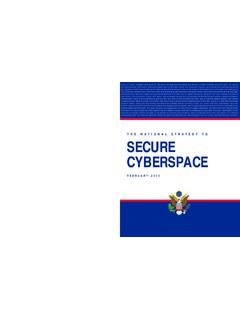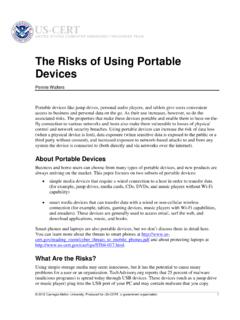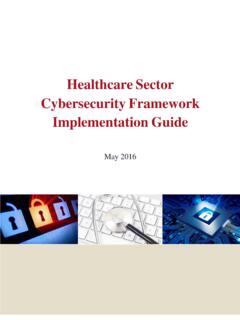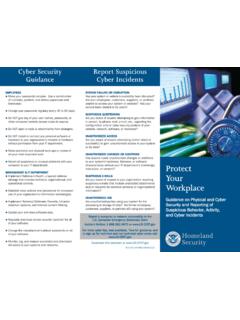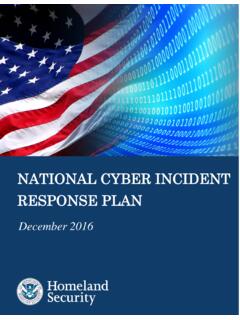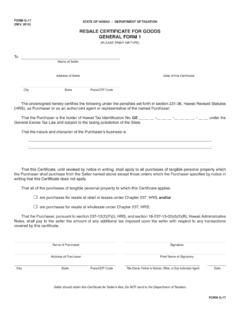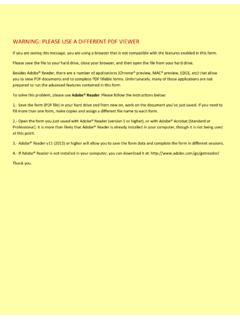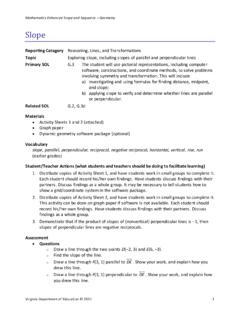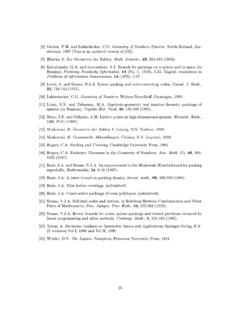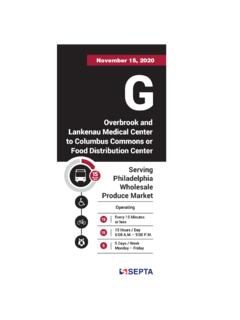Transcription of MAR-10135536-G Malware Analysis Report
1 TLP:WHITE Malware Analysis Report (MAR) - 10135536-G 2018-02-06 Notification This Report is provided "as is" for informational purposes only. The Department of Homeland Security (DHS) does not provide any warranties of any kind regarding any information contained within. The DHS does not endorse any commercial product or service, referenced in this bulletin or otherwise. This document is marked TLP:WHITE. Disclosure is not limited. Sources may use TLP:WHITE when information carries minimal or no foreseeable risk of misuse, in accordance with applicable rules and procedures for public release. Subject to standard copyright rules, TLP:WHITE information may be distributed without restriction. For more information on the Traffic Light Protocol, see /tlp/. Summary Description This Malware Analysis Report (MAR) is the result of analytic efforts between the Department of Homeland Security (DHS) and the Federal Bureau of Investigation (FBI).
2 Working with Government partners, DHS and FBI identified Trojan Malware variants used by the North Korean government - referred to by the Government as BADCALL. The Government refers to malicious cyber activity by the North Korean government as HIDDEN COBRA. For more information on HIDDEN COBRA activity, visit https[:]//www[.] /hiddencobra. FBI has high confidence that HIDDEN COBRA actors are using Malware variants in conjunction with proxy servers to maintain a presence on victim networks and to further network exploitation. DHS and FBI are distributing this MAR to enable network defense and reduce exposure to North Korean government malicious cyber activity. This MAR includes Malware descriptions related to HIDDEN COBRA, suggested response actions and recommended mitigation techniques. Users or administrators should flag activity associated with the Malware , Report the activity to the DHS National Cybersecurity and Communications Integration Center (NCCIC) or the FBI Cyber Watch (CyWatch), and give the activity the highest priority for enhanced mitigation.
3 This Report provides Analysis of three (3) malicious executable files. The first two (2) files are 32-bit Windows executables that function as proxy servers and implement a "Fake TLS" method similar to the behavior described in a previously published NCCIC Report , MAR-10135536-B. The third file is an Android Package Kit (APK) file designed to run on Android platforms as a fully functioning Remote Access Tool (RAT). The following YARA rule may be used to detect the proxy tools: rule NK_SSL_PROXY{ meta: Author = "US-CERT Code Analysis Team" Date = "2018/01/09" MD5_1 = "C6F78AD187C365D117 CACBEE140F6230" MD5_2 = "C01DC42F65 ACAF1C917C0CC29BA63 ADC" Info= "Detects NK SSL PROXY" strings: $s0 = {8B4C24088A140880F24780C228881408403BC67 CEF5E} $s1 = {568B74240C33C085F67E158B4C24088A140880E A2880F247881408403BC67 CEF5E} $s2 = {4775401F713435747975366867766869375E252 4736466} $s3 = {67686667686A75797566676467667472} $s4 = {6D2A5E265E676866676534776572} $s5 = {3171617A5853444332337765} $s6 = "ghfghjuyufgdgftr" $s7 = "q45tyu6hgvhi7^%$sdf" $s8 = "m*^&^ghfge4wer" TLP:WHITE US-CERT MAR-10135536-G 1 of 13 TLP:WHITE condition.}
4 ($s0 and $s1 and $s2 and $s3 and $s4 and $s5) or ($s6 and $s7 and $s8) } Files Processed 3 c01dc42f65acaf1c917c0cc29ba63adc (C01DC42F65 ACAF1C917C0CC29BA63 ADC) c6f78ad187c365d117cacbee140f6230 (C6F78AD187C365D117 CACBEE140F6230) d93b6a5c04d392fc8ed30375be17beb4 (D93B6A5C04D392FC8ED30375BE17 BEB4) TLP:WHITE US-CERT MAR-10135536-G 2 of 13 TLP:WHITE Files C6F78AD187C365D117 CACBEE140F6230 Details Name C6F78AD187C365D117 CACBEE140F6230 Size 208896 Type PE32 executable (GUI) Intel 80386, for MS Windows MD5 c6f78ad187c365d117cacbee140f6230 SHA1 5116f281c61639b48fd58caaed60018bafdefe7a ssdeep 1536:X86D0r4 QxG5+XCFpaG7+esyzktLYUwnZ7hUOKYUwnZ7hUOa eYUwnZ7hUOKYUwnZr:X8O0 IgCvH7+UzktMxzxgRxzx 9 Entropy Antivirus Ahnlab PE Information Compiled 2016-02-07T03:17:51Z PE Sections Name MD5 Raw Size Entropy (header) a8f97910c62034b318e17aa17fb97f1c 4096 .text 08112b571663ff5ed42e331a00ccce0c 53248.
5 Rdata ca61927558a4dfe9305eb037a5432960 8192 .data bb49b2fb00c1ae88ad440971914711a7 139264 .sxdata c58b62cf949e8636ebd5c75f482207c3 4096 Packers Name Version Entry Point Microsoft Visual C++ NA NA Relationships (F) C6F78AD187C365D117 CACBEE140F6230 Related_To (S) Figure 1 (c6f78) (F) C6F78AD187C365D117 CACBEE140F6230 Related_To (S) Figure 2 (c6f78) (F) C6F78AD187C365D117 CACBEE140F6230 Related_To (S) Figure 3 (c6f78) (F) C6F78AD187C365D117 CACBEE140F6230 Related_To (S) Figure 4 (c6f78) Description This file is a malicious 32-bit Windows executable. Analysis indicates this application is designed to force a compromised system to function as a proxy server. When executed, the Malware binds and listens for incoming connections on port 8000 of the compromised system. The proxy session traffic is protected by way of a simple cipher based on rotating XOR and ADD. The cypher will XOR each byte sent with 47h and added by 28h.
6 Each byte received by the Malware will be XOR ed by 47h and subtracted by 28h. See Screenshots 1, 2 & 3 for code examples. Notably, this Malware attempts to disable the Windows firewall before binding to port 8000 by modifying the following registry key: --Begin Firewall Reg Key Modified--SYSTEM\CurrentControlSet\Servi ces\SharedAccess\Parameters\FirewallPoli cy\StandardProfileGloballyOpenPorts\\Lis t --End Firewall Reg Key Modified-- Analysis of this Malware indicates it is designed to turn a victim host into a "hop point" by relaying traffic to a remote system. When the adversary initially connects to a victim s machine via port 8000, they must first authenticate (over a session secured with the XOR/ADD cipher described above) by providing the ASCII string "1qazXSDC23we . If the Malware does not receive this value, it will terminate the session, responding with the value "m*^&^ghfge4wer.
7 If the operator authenticates successfully, they can then issue the command "ghfghjuyufgdgftr" which instructs the Malware to begin TLP:WHITE US-CERT MAR-10135536-G 3 of 13 TLP:WHITE functioning as a proxy server and respond to the operator with the value "q45tyu6hgvhi7^%$sdf . Next, the Malware attempts to create a proxy session between the operator and another server. During this process, the Malware will attempt to authenticate with the destination server by sending the value "ghfghjuyufgdgftr" as a challenge. To complete the authentication sequence, the Malware expects to receive a response value of "q45tyu6hgvhi7^%$sdf". All challenge & response traffic is encoded using the ADD/XOR cipher described earlier. Importantly, the connection from this proxy Malware to the target proxy system will begin via a "fake TLS" connection attempt, similar to the behavior described in a previously released NCCIC Report , MAR-10135536-B.
8 Essentially, the Malware initiates the TLS session using one of several public SSL certificates obtained from well known, legitimate internet services and imbedded in the Malware . The Malware begins a TLS session with the proxy target by issuing calls to the OpenSSL functions SSL_new(), SSL_set_fd, and SSL_connect(). The Malware then sends and receives initial data (authentication values) to and from the target proxy system using the OpenSSL functions SSL_read() and SSL_write(). However, the Malware never completes the TLS handshake, instead decoding the data upon receipt using the XOR/ADD cipher described earlier. See Figures 1-4 for code examples of this process. The following is a list of the domains for which the Malware contains public SSL certificates, used for initiating the "FAKE TLS" sessions: --Begin SSL cert list www[.] www[.] www[.] www[.] www[.] www[.] www[.]
9 ] www[.] www[.] www[.] www[.] www[.] www[.] www[.] www[.] www[.] www[.] -- End SSL cert list--Screenshots Figure 1 TLP:WHITE US-CERT MAR-10135536-G 4 of 13 TLP:WHITE Operator providing command to authenticate with proxy Malware . Figure 2 TLP:WHITE US-CERT MAR-10135536-G 5 of 13 TLP:WHITE Cipher used to protect the data received by the proxy server. XOR and ADD instructions are used to decode traffic send from the Malware . Figure 3 TLP:WHITE US-CERT MAR-10135536-G 6 of 13 TLP:WHITE Cipher used to protect the data sent from the proxy server. Figure 4 TLP:WHITE US-CERT MAR-10135536-G 7 of 13 TLP:WHITE Code demonstrating author's intent to decrypt traffic using imbedded cypher instead of relying on proper implementation of SSL C01DC42F65 ACAF1C917C0CC29BA63 ADC Details Name C01DC42F65 ACAF1C917C0CC29BA63 ADC Size 233472 Type PE32 executable (DLL) (GUI) Intel 80386, for MS Windows MD5 c01dc42f65acaf1c917c0cc29ba63adc SHA1 d288766fa268bc2534f85fd06a5d52264e646c47 1536:cseScclTQDYY3 TSF00sK/LVtKYUwnZ7hUO1 YUwnZ7hUOAeYUwnZ7hUO7 YUwnZ7hj:cseScjYY3 Tyc0 LVt9xsxuRxSxz xg0j ssdeep Entropy Antivirus nProtect F-secure BitDefender Microsoft Security Essentials Emsisoft Ahnlab Ikarus PE Information Trojan:Win32 !
10 Dha (B) Compiled 2016-02-05T18:16:54Z PE Sections Name (header) .text MD5 f0cb80c557b1172362064c51bbb9b271 e9d0219343e64c8c8aa6f084db44b92c Raw Size 4096 45056 Entropy TLP:WHITE US-CERT MAR-10135536-G 8 of 13 TLP:WHITE .rdata 1092801819f120298e2ddac6a96e3fd0 8192 .data 5109fb1db61b533c23762d9044579db7 167936 .reloc 9ce04d3e820fa7056f351dbcfa05b0fb 8192 Packers Name Version Entry Point Microsoft Visual C++ NA NA Microsoft Visual C++ DLL (Debug) NA NA Relationships (F) C01DC42F65 ACAF1C917C0CC29BA63 ADC (c01dc) Related_To (S) Figure 5 (F) C01DC42F65 ACAF1C917C0CC29BA63 ADC (c01dc) Related_To (S) Figure 6 (F) C01DC42F65 ACAF1C917C0CC29BA63 ADC (c01dc) Related_To (S) Figure 7 Description This file is a malicious 32-bit Windows DLL. Static Analysis indicates this application is very similar in structure and function to C6F78AD187C365D117 CACBEE140F6230.

